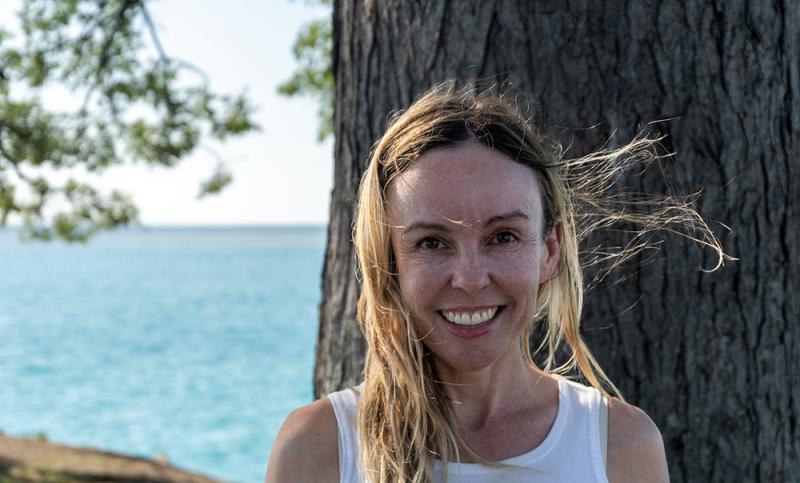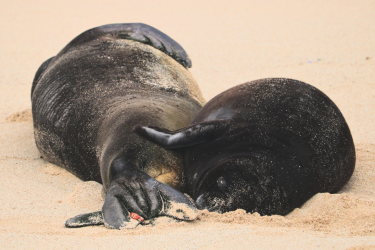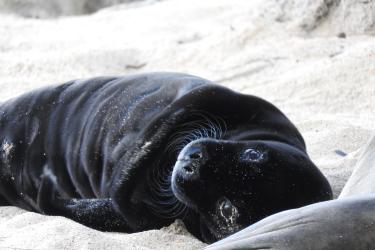What do you do at NOAA Fisheries?
I am the Regional Marine Wildlife Response Coordinator for the NOAA Fisheries Pacific Islands Regional Office.
My role is to coordinate response to stranded marine mammals in the Pacific Islands region, including in the territories. How we have it structured here in Hawaiʻi is that we have island-specific coordinators on Maui, Hawaiʻi Island, and Oʻahu. I work as a coordinator not just for marine mammals, but also for my colleagues. I help make sure that they have what they need to do their jobs and that our response in the Hawaiian Islands as well as the U.S. territories is coordinated and supported.
A response to a marine mammal might range from working with our great teams and partners to setting up perimeters around resting monk seals. And doing outreach and education for the public so they understand what’s going on and what they’re seeing on the beach. Or, we might work collaboratively with the Pacific Islands Fisheries Science Center and our partners to engage in a hands-on response if a marine mammal is in need of assistance.
In the territories, we are working to continue and expand partnerships in these areas to do similar things. We have fewer strandings in the territories, but we want to make sure that we can respond as best as possible to any dolphin or whale that might strand.
One of the amazing aspects of my job is the great team I work with. I love how we are working together to support each other and it is a great feeling to work with those colleagues, both here and with our external partners. We are lucky to have such a dedicated team of people here in the Pacific Islands region who share the same goals of conservation and recovery of protected species.
How did you get interested in marine mammals?
I’ve loved marine mammals and the ocean from before I can even remember. My mom had me learning to swim before I could walk, and as soon as I was old enough, I was volunteering at aquariums. For example, when I was younger, I lived for a period of time in the Chicago area. I spent a lot of time volunteering at the Shedd Aquarium, where they have all kinds of great marine wildlife care, conservation, and education programs. I did everything from preparing fish for the marine mammals there to helping with summer education programs for young people. When I lived in California, I spent every chance I had viewing marine mammals in the wild, swimming in the ocean, and doing beach cleanups!
From there, I studied marine biology at the University of Miami in Florida. I had the opportunity to gain exposure to the research side of marine science, both through regular coursework, which included snorkeling trips in the Florida Keys, and extra work volunteering in the lab of one of the University’s top shark researchers. It’s been a lifelong passion and I just feel so lucky that I have been able to pursue a career in something I have loved my whole life.
When you initially envisioned working with marine mammals, is this the career you envisioned?
As a young person, I wasn’t initially aware of all the career opportunities that are available in the marine wildlife field. So growing up I always thought that the only career path was to work at a zoo or aquarium as a marine mammal trainer.
But as I went to school and started working, I started to learn more about all the different opportunities there are in the marine mammal and marine science world. It’s cool because there’s something for everyone, no matter where your skill set is or where your particular interests lie. For example, you could do education, you could do policy, or you could do hands-on work to make a contribution to marine conservation.
What is your favorite marine mammal and why?
Although it’s a bit common or stereotypical, my favorite marine mammal is the bottlenose dolphin. The joy and the personality that they bring every time you see them just makes you happy. When living in California, sometimes I would just go sit on the beach and watch them swim by, playing and surfing in the waves. And ever since I moved to Hawaiʻi, Hawaiian spinner dolphins have been high on the list for me, too. The aerial displays they do are amazing.
What is an experience that helped prepare you for your current role?
The Marine Mammal Center is a nonprofit that does marine mammal rescue, rehabilitation, and research in California. Prior to joining this office, I worked there for 4 years. I managed a triage hospital where I led a team in responding to, rescuing, and caring for a variety of stranded marine mammals (and sometimes sea turtles!). It was such a great experience because I had hundreds and hundreds of hands-on hours in almost every kind of marine wildlife response you can imagine. That includes taking calls from the public about stranded marine mammals and engaging with people on the phone directly, to going out myself to see if the stranded animals needed assistance or if they were best left alone. And I also conducted rescues and provided medical care for the marine mammal patients that needed it at the hospital. And beyond that, I helped with a very active education and outreach program in the community.
Now I am in a role looking at the bigger picture of stranding response. It helps so much to have the understanding of what goes into each aspect of marine wildlife response since I did all of those activities personally. Having that first-hand knowledge helps me to really be able to understand the work of our teams and partners—and empathize with the challenges they face—and hopefully to support and help organize our work in a way that works well for all of us.
What comes to mind when you reflect on your first year in your role?
I am truly enjoying my "new" role. The year has flown by and I’ve met and worked with great partners both inside and outside of NOAA from across the region. This includes Hawaiʻi, Commonwealth of the Northern Mariana Islands, Guam, American Samoa, and even the Marshall Islands! I've learned that the marine mammals of the Pacific Islands are just like marine mammals of the West Coast, in that they seem to know when it is a holiday or a Friday night—and always seem to pick those times to strand! That is why we have a 24-hour hotline and someone on-call every day of the year. It allows us to respond to cases such as the seal that rested in a bus pullout lane on the 4th of July this year, or the dolphin strandings that occurred on Thanksgiving! All of these cases and many more emphasize that we rely on a huge network to accomplish our work, including all of our NOAA colleagues who might spot a stranded animal while walking on a beach and call it in to our statewide marine wildlife hotline; our fellow NOAA staff who help in the territories where resources are limited; and state, nonprofit, and community partners who help on the ground during a stranding. Thank you all for making this a great first year!
Is there a book, quote, or person that influenced you to be the person that you are today?
I don’t think there’s something specific—it’s more about all the people I worked with. One thing I think is unique in working with wildlife is that people generally do it because they’re passionate about it, and they care about it. You’re not in this work for the money or glory. Ever since I started volunteering, I saw the dedication and passion that people brought to their work. And that was so motivating to me and inspired me to work hard and care about what I do, and to incorporate my love of marine wildlife and my passion into my career. So I think it was the small things that really motivated me to be who I am versus one big thing.
Is there anything you’d like the public to know about marine mammals?
We are so lucky to be in areas where we are able to see marine mammals. I think it’s so important that we do so in a way that respects the animals’ space and gives them the opportunity to be wild animals.
The best thing people can do when they see one in distress is to call the NOAA Marine Wildlife Hotline at (888) 256-9840. We want to make sure we can do what’s best for the animal—sometimes that’s just giving them space, and sometimes intervention is necessary.
What advice would you have for youth interested in a career with NOAA Fisheries?
Pursue your passion and areas of interest. There are so many ways to get involved with NOAA, from scientific research to policy to education and outreach jobs. Also, work hard in whatever job you’ve been given. Just put all you can into it and learn everything you can, whatever it might be, and eventually people will recognize that and it will take you somewhere.
After graduating from school, I worked for the U.S. State Department for 10 years and I did, for the most part, non-marine science work. I really wanted to travel and learn languages and see other places in the world, so I took a detour from my career. But a lot of the skills that I gained in that work, such as being calm in stressful situations and working with people from all kinds of cultural backgrounds, has really benefited me in my current work. So even if you’re not in a job that is 100 percent what you thought you wanted to do, there are always skills and opportunities for learning in any position that will benefit you in the future.




